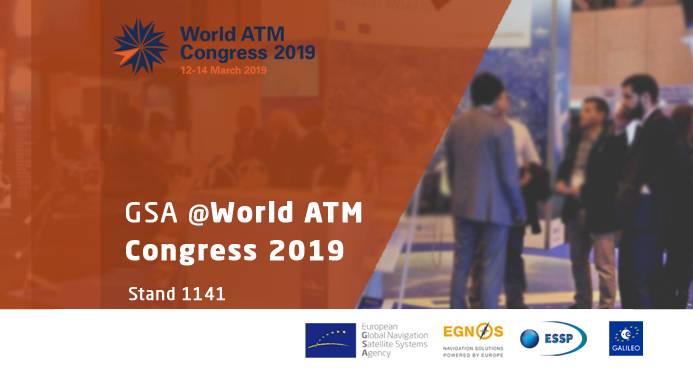
The European GNSS Agency (GSA) is organising a workshop on EGNOS and Galileo services for aviation on March 13 as part of the World ATM Congress in Madrid. At the session, a number of speakers will discuss the current status of EGNOS and Galileo implementation in the sector, potential new services and will gather priorities for research and development funding from the sector.
EGNOS currently enables localizer performance with vertical guidance (LPV), the performance-based navigation (PBN) alternative to ILS Cat I, supporting advanced arrival procedures and facilitating Point in Space (PinS) for helicopters. EGNOS positioning also increases the availability of ADS-B (Automatic Dependent Surveillance-Broadcast). Meanwhile, Galileo receivers are included in Search and Rescue beacons and new Galileo services for the aviation community are being explored.
At the workshop, which will take place at 10.10 – 11.10 in the FABEC Conference Room, GSA Market Development Officer and Horizon 2020 Coordinator Carmen Aguilera will provide an update on these and other EGNOS and Galileo services supporting aviation operations now and in the future. The session will also be an opportunity to discuss R&D priorities and new funding opportunities.
Supporting compliance
Christian Belleux, Director at PNT solution provider Orolia will talk at the workshop about how Galileo can help airlines comply with the upcoming European mandate on aircraft distress tracking and the new Standards and Recommended Practices (SARPs) from the International Civil Aviation Organisation (ICAO) relating to the location of an aeroplane in distress.
These new SARPs relate to Autonomous Distress Tracking (ADT), which is part of the Global Aeronautical Distress and Safety System (GADSS) initiative launched by ICAO, which became effective on 11 July 2016 and will be applicable from 1 January 2021. In Europe, the Rule on ‘location of an aircraft in distress’ – CAT.GEN.MPA.210 covers this ICAO provision and is applicable to large aeroplane manufacturers from Jan 2021 onwards.
Robustness and accuracy
In his presentation at the workshop, Pere Molina, Advanced Applications Programme Manager at GeoNumerics, will highlight how EGNSS (Galileo and EGNOS) can help smooth out drone integration into current and future ATM and UAV traffic management (UTM) concepts.
Drone technology is serving all kinds of professional applications related to the air segment - from inspection, surveillance and surveying, to package delivery and ultimately even passenger transport. These applications are safety- and/or liability-critical and the robustness and accuracy provided by EGNOS and Galileo has a lot to offer in this regard. However, the potential of EGNOS and Galileo are currently underexploited, which is a big missed opportunity, according to Molina.
A representative from the European Satellite Services Provider (ESSP), which specialises in the operation and provision of satellite-based services for aviation, will discuss working with new EGNOS users to enable flying Instrument Flight Rules (IFR) in Visual Flight Rule (VFR) environments. To support the European Aviation Safety Agency’s (EASA) goal of enabling IFR for general aviation, all stakeholders will work together to identify topics that need further assessment and propose solutions where EGNOS can help increase safety levels.
World ATM Congress
Now in its seventh year, this year’s World ATM Congress will take place in IFEMA, Feria de Madrid, on 12-14 March and will bring together the world’s leading product developers, experts, stakeholders, and air navigation service providers (ANSPs) for three days of conference sessions, product demonstrations and launches, and educational and networking opportunities.
For more information, visit the WATM website.

